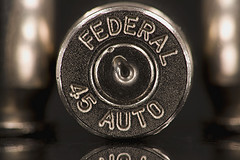The Power of Symbolism: A Guest Post by Nann Dunne

by Nann Dunne
Recently, I watched an episode of CSI:NY that had a scene that impressed me enough to stick in my mind. In the scene setup, the character Jo, a policewoman played by Sela Ward, accompanies a female witness home.
Shortly after the woman goes into her bedroom to get some clothes, Jo calls out a question to her. When the woman doesn't answer, Jo walks to the bedroom door. She sees the woman's legs on the floor past the end of the bed. She draws her gun and slips into the room. She gets punched in the face, and the gun drops from her hand.
Fade out.
Fade in, minutes or hours later, we aren't sure.
Jo is lying on the living room floor, regaining awareness. A man, the serial rapist her unit has been pursuing, forces her to her feet, beats her with his fists, and slams her against a wall mirror. She falls to the floor, bleeding and barely conscious.
The rapist has her gun. He ejects the magazine into his hand and sets the gun on the coffee table. He sits in a chair and slowly flicks the bullets out of the magazine at Jo, one by one. All the while, he taunts her about how he has outsmarted the police.
He laughs and even encourages Jo as she inches across the floor to the table and wraps her hand around the gun butt.
Finally, the gun now in her hand, she struggles to a sitting position, points it at him and says in a raspy voice, "You know how most gun accidents happen and people shoot themselves?"
The guy, now sneering at her, stands up and spreads his arms wide. "Bang! You got me. You finally got me."
Jo gets that look on her face. You know the one. When a person is sure she's won the battle.
The unspoken moment between them — which we understand better than he does — is priceless.
She says, "They always forget the one in the chamber."
The camera cuts to the rapist. Realization dawns. His face sobers. His body twitches. The camera turns back to Jo… she pulls the trigger.
Out of the thousands of scenes I've watched over the years, this onewill stay with me.
We all like to see the bad guy get his due, and in most crime shows, he or she usually does. I asked myself what makes this scene more memorable than those others?
The answer I arrived at? The symbolism of the bullet in the chamber.
The scene is an allegory of life.
We can be sailing along with everything going smoothly, then, bam! Something turns our little part of the world topsy-turvy. The upset can affect us physically, mentally, or emotionally; it can be as small as fighting a case of the flu or as large as losing a loved one to the finality of death. Often it seems our small segment of the world shows no sympathy, even laughing at us, as we battle to return to stability.
If we keep our wits about us, as Jo did, and do our best to resolve the situation, we can find deep inside ourselves the power that the bullet symbolizes—the steel force we have ingrained in us that can give us the strength and courage to win against the struggles we face.
Symbolism in writing is a mighty tool.
We who are authors should strive to write memorable scenes that mean more than their face value. We can't use symbolism in every scene, but two or three per book is a reachable goal.
Some common symbols, for example, are flags for patriotism; rings for commitment; the Statue of Liberty for freedom, smiley faces for happiness and friendship. We also have the not-so-nice symbols: finger-flipping for contempt; the "raspberry" for derision; the twirling finger at the temple for craziness.
And there are uncommon symbols. Images and moments that allow the reader to assign their own meaning.
Have you read or seen scenes that had such a strong effect on you that you still remember them? Ask yourself why—was symbolism involved? Use that memory as a basis to fashion your own original symbols within your story. Work to strengthen your recognition of symbolism – read some poetry, listen to songs… poets and lyricists rely on symbolism to imbue their work with power and depth.
Symbolism reaches into our readers' minds and hearts and touch them in ways they didn't foresee. To create these moments in our stories is to write with power.
Remember the bullet still in the chamber. Use it in your writing—and in your life.
Have you written any symbolism in your work? Do you remember any outstanding use of symbolism in what you've read?
Nann Dunne is the a uthor of Dunne With Editing: A Last Look At Your Manuscript
Check it out at www.nanndunnebooks.com.
See Nann's novels at www.nanndunne.com.
Read Nann's blog at www.justaboutwrite.com/blog
Image courtesy of kcdsTM
Also… check out a guest post by frequent Storyfix contributor Art Holcomb on Routines For Writers.
The Power of Symbolism: A Guest Post by Nann Dunne is a post from: Larry Brooks at storyfix.com



